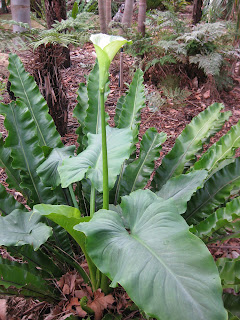
Cannas are native to tropical regions of South America. They became very popular in Victorian times and were grown widely in Europe and the USA. Most Cannas grown these days are cultivars
there are approximately 2000 known varieties. Some of the varieties are grown especially for their edible roots from which starch is obtained, but the leaves and young seed are also edible, and canna was once a staple food crop in Peru and Ecuador. In more remote regions of India, cannas are fermented to produce alcohol ( can you imagine! I wouldn't try it though...)
There is nothing as simple as growing Cannas! They grow best in full sun with moderate watering over the hot summer days, they drought tolerant and will grow in any soil but would prefer sandy types. A thick layer of mulch is always beneficial as it keeps plant roots nice and cool in summer and relatively warm in winter. Canna lily will add an exotic and tropical look to your garden. There are different leaf and flower colors available for you to choose from!




